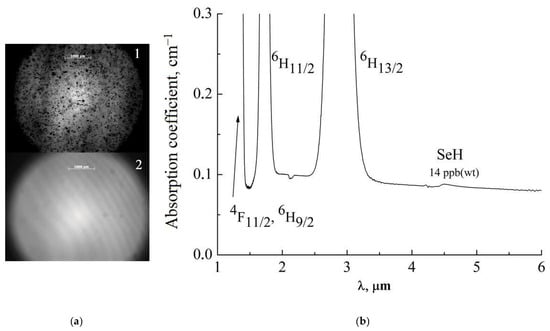You're using an outdated browser. Please upgrade to a modern browser for the best experience.
Please note this is a comparison between Version 1 by Sergei Sverchkov and Version 2 by Jessie Wu.
The main source of impurities in the doped selenide glasses are rare-earth metals and their precursors (halides, chalcogenides). The total optical losses in glasses caused by impurities brought with rare-earth metals at a doping level of 1000 wt ppm can reach 10–85 dB/m.
- selenide glass
- chalcogenide optical fiber
- mid-infrared glass laser
1. Introduction
Various applications require the use of laser radiation from the mid-infrared (MIR) spectral range [1]. The sources of coherent radiation can be divided into two large groups: lasers based on population inversion and wavelength converters based on nonlinear optics. This resviearch w is not concerned with nonlinear optical devices and is devoted to newly developed solid-state laser materials emitting within the mid-infrared range. At the present time, broadband-gain media suitable for tunable lasers as well as for ultrashort pulse amplifiers are being actively investigated. Compact solid-state laser systems are of particular interest.
In the 1980s, color-center lasers [2] found widespread use in various applications, especially in spectroscopy. The main drawbacks complicating the usage of these lasers include the instability of the laser-active color centers and the necessity for cryogenic cooling, especially in the mid-infrared spectral region.
Although quantum cascade lasers [3] provide access to a large part of the MIR, their fabrication is still expensive, while the output powers/energies are orders of magnitude below the solid-state lasers’ (SSLs’) performance.
Significant progress in the development of MIR solid-state lasers has been achieved in crystals based on Fe2+-doped chalcogenide materials [4][5][6][7][8][4,5,6,7,8], among which the longest wavelength tuning range of 4.5–6.8 µm was achieved with the Fe2+:CdTe laser. However, the short upper-state lifetimes (in the sub-µs range) and the need for cryogenic cooling make the implementation of these lasers difficult in practice.
Rare-earth-ion-doped short phonon-spectra crystals and glasses have long been considered promising host materials for lasers operating in the mid-infrared range. Their undoubted advantages over Fe2+ and color-center lasers are the millisecond lifetimes of the upper laser levels, enabling long pump pulses. The number of papers describing rare-earth-doped crystalline laser materials for wavelengths exceeding 4 μm is rather limited. These lasers are still in their infancy, and their output energies are typically well below 1–2 mJ [9][10][11][12][9,10,11,12].
The main advantage of glasses over crystals is the possibility to draw optical fibers from them. This fiber configuration easily allows efficient cooling that is required for continuous operation and diffraction-limited beam quality. However, until 2020, the longest wavelength emitted by a rare-earth-doped glass laser was 3.92 µm. It was a Ho-doped indium fluoride glass–fiber laser [13]. Further wavelength increases in fluoride laser glasses is prevented by the multiphonon luminescence quenching of rare-earth-ion transitions.
It should also be noted that, in parallel, work is being developed with gas-filled hollow optical fibers, which demonstrate coherent radiation in the mid-infrared range due to either inversion or stimulated Raman scattering [14][15][14,15].
2. Preparation of Rare-Earth-Ion-Doped High-Purity Glasses Based on Germanium, Antimony and Gallium Selenides
Traditional preparation methods of undoped high-purity glasses based on arsenic, germanium and antimony chalcogenides include the distillation of initial components and charging. This makes it possible to reduce the content of most nonvolatile impurities as well as the content of gas-forming impurities (hydrogen, oxygen) and of heterogeneous inclusions. The difficulty in applying this approach to the preparation of rare-earth-doped glasses and glasses containing gallium is that Ga and rare-earth metals and their chalcogenides are not volatile, even at relatively high temperatures (over 750 °C) and cannot be purified by simple distillation or by distillation after melting with chemical getters that reduce the content of hydrogen and oxygen impurities. As a result, the minimum achieved content of hydrogen impurity in the form of Se-H groups in rare-earth-doped chalcogenide glasses was about 10 ppm [16][17][28,29]. This is 1–2 orders of magnitude higher than in undoped glasses. The content of other impurities (heterogeneous inclusions, transition metals) was not analyzed in the literature. The authors of [18][30] have developed methods for the preparation of high-purity chalcogenide glasses of the Ge-Se(S), Ge-As-S and Ga-Ge-As-Se systems using germanium loading by chemical distillation of its volatile monochalcogenide and gallium loading by chemical transport reactions. These methods have made it possible to reduce the content of hydrogen impurities in the form of Se-H groups and oxygen in the form of Ge-O groups to a level of 0.01–0.1 ppm. Based on these methods, rwesearchers have proposed a two-stage procedure for the preparation of rare-earth-doped chalcogenide glasses, in which all the charge components (Ge, Sb, Ga, Se) as well as the rare-earth metals are loaded and additionally purified by a combination of germanium and antimony selenide distillation and the chemical vapor transport of gallium and rare-earth metal iodide under high vacuum conditions. Using this method, high-purity Ga5Ge20Sb10Se65 glasses doped with Ce, Pr, Nd, Tb and Dy were prepared. This composition remains crystallization-stable up to a rare-earth-ion concentration of about 1020 cm−3. This is a sufficiently high value, which makes it possible to utilize the processes of nonradiative excitation transfer between active ions and thus to organize complicated (cross-relaxation, sensitization) pumping schemes. An advantage of the developed method is the synthesis and loading of hygroscopic iodides of rare-earth metals under high vacuum conditions, which makes it possible to significantly reduce the content of hydrogen- and oxygen-containing impurities as well as that of heterogeneous inclusions in glasses (Figure 1a).
Figure 1. (a) Overview of optical microscopic images of micron-sized inclusions in rare-earth-doped glasses prepared by the traditional method (1) and by the method (2) described in [18][30]. (b) Attenuation spectrum of Ga5Ge20Sb10Se65 glasses doped with 1.0 wt % of Dy prepared as described in [18][30].
